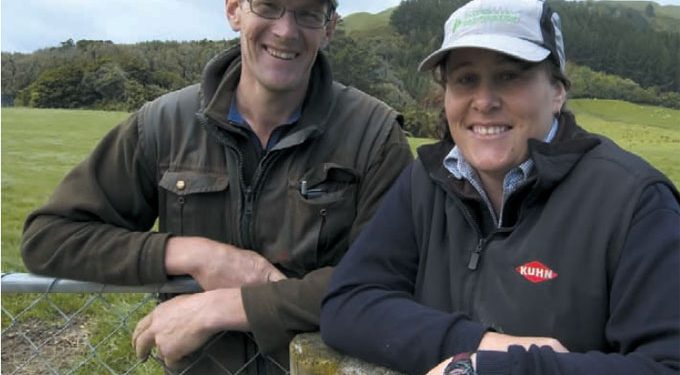You must be logged in to post a comment.
Archive

Tom and Abi Richmond farm their property inland from Te Horo, situated along the Kapiti coastline. At one stage their property would’ve been a beachfront location, but over time the land has done a good job at pushing the ocean 10km west, leaving fertile flat land in its wake.
| Type of operation | Deer, dairy grazing, fattening |
|---|---|
| Years of dicalcic use | 6 |
| Size of farm (effective) | 485ha |
| Stocking rate | 5.7 su/ha |
| 2008 production | 18.5kg (av) lambs/160% docked |
| Average rainfall | 1050-1100mls |
| 2008 product used and application rate | No.8S @ 300kg/ha, plus haymix on specific paddocks |
The Richmond’s farm takes in 120ha of this, while another 365ha spans briefly eastward over medium hill country, before turning steeply into exposed paddocks and regrown native bush. Tom was born and raised here, before completing a Diploma of Agriculture at Massey, and is now the third generation on the farm, while Abi’s family lived twenty minutes down the road. Their first foray into farming was a 50:50 sharemilking family arrangement on the 50ha. Meanwhile, Tom’s parents, Jock and Jan, were running a deer operation on the hill country after successfully trapping them on the farm twenty-five years ago. It’s a role they still actively manage today.
When dairying became uneconomical, Tom and his parents made the decision to switch to using the land for cropping and fattening, and incorporating it into the rest of the farm. ‘We run separate systems for the deer and the beef, they’re both easy care,’ says Tom. ‘The hills run all the breeding hinds and in the winter the cows go in to clean it up, while all the progeny, the fawns at weaning time, come down to the flats. We fatten the steers and heifers on the flats most the year, as well as cut all our own hay and baleage.’
Hatuma’s dicalcic phosphate was first applied straight after they stopped dairying. Traditionally, copious amounts of chicken manure from the poultry sheds on the farm were used. They’d been there since the 1970s when a local man, the founder of Gold Coast Poultry, talked Tom’s parents into growing broiler chickens on contract. So, every two months, there was approximately 30 tonne of chicken waste produced, and consequently spread over the flat areas of the farm. ‘But we haven’t used chicken fert here for over ten years. It’s given us a P reserve in the ground that doesn’t look like fading. When I finished dairying we didn’t apply any more concentrated fertiliser and consequently we didn’t get any more growth. So we went to dicalcic to help raise the pH, which was pretty low by that stage, and to help release the phosphate that was there. We used a dicalcic and Cropfine blend for two years in a row, then continued using the No.8S blend at a lower rate, as well as some Haymix in different paddocks. We’ve only flown it on the hill country twice in that time, but a few months after the first application the response was amazing. I can still see where the plane stopped.’



 520 Maharakeke Rd, Waipukurau
520 Maharakeke Rd, Waipukurau

 0800 80 65 65 /
06 858 8567
0800 80 65 65 /
06 858 8567 06 8588018
06 8588018
Leave a Reply